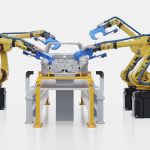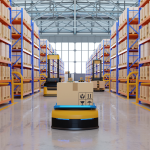As labor volatility persists and tariff uncertainty rises, supply chain leaders are turning to robotic sortation—not just to cut costs, but to rethink how fulfillment networks are built and scaled.
From Labor Band-Aid to Network Design Tool
Autonomous mobile robots (AMRs) were once adopted to patch labor shortages. Now, they’re doing something more consequential: changing how warehouses are configured, how throughput is scaled, and how logistics operations flex in real time.
Market projections support the shift. According to Dataintelo, the robotic sortation market is forecast to grow at more than 17% CAGR through 2032, driven by adoption in warehousing, logistics, and manufacturing. But the strategic rationale is evolving. These systems are no longer just about headcount reduction—they’re giving operators a modular, scalable way to build fulfillment networks that can respond to demand surges without overbuilding.
This shift is coming into sharper focus as macro pressures converge. Tariff uncertainty is compressing sourcing cycles. Facility costs and real estate constraints are squeezing regional distribution strategies. And workforce churn is forcing companies to build operations that can perform predictably even under severe labor shortages. Flexible automation—especially in sorting and packing—is proving to be the lever that absorbs all three.
Early-stage deployment levels support that long-term view. Interact Analysis reports that by 2030, only 13% of warehouses globally will have deployed even a single fulfillment AMR—underscoring the latent potential for those who move early and design with flexibility in mind.
Inside DHL’s High-Throughput Sortation Model
DHL Supply Chain’s Columbus, Ohio facility offers a real-world case of how AMR-driven sortation can transform both flow and facility function. In partnership with Addverb Technologies, DHL installed 52 “Zippy” robots to manage carton and parcel sortation across 80 destinations. The system integrates conveyors, scanning/weighing modules, and intelligent routing to automate movement and placement—freeing up human workers for quality control and pallet assembly.
Key to the system’s impact is its ergonomic design. Once items are inducted, no manual handling is required until the final scan and pallet build stage. Workers no longer walk long distances or repetitively bend to move cartons. Instead, each robot delivers the right item to the right station at the right moment—reducing fatigue while increasing throughput.
Since implementation, productivity at the site has tripled. But the real differentiator is adaptability. The AMR fleet can be scaled up or down without layout changes, allowing DHL to respond to peak cycles without adding headcount or expanding physical space—a significant advantage in an environment where demand patterns shift faster than infrastructure can keep up.
Where Fulfillment Design Is Headed Next
Robotic sorting isn’t just an efficiency upgrade—it’s a structural rethink. For years, fulfillment operations have scaled by expanding square footage or labor. Now, the smartest operators are scaling through configurability. The ability to dial throughput up or down, reconfigure workflows on the fly, and weather labor or demand shocks without tearing up floor plans—that’s becoming the new definition of resilience.
It’s easy to get caught up in the tech specs. But what’s more interesting is what this shift says about the future of warehouse design: lighter, faster, more modular. In an era where cost volatility and sourcing disruption are the norm, the real edge isn’t who moves the fastest—it’s who can adapt the fastest, without waiting for a building permit.







